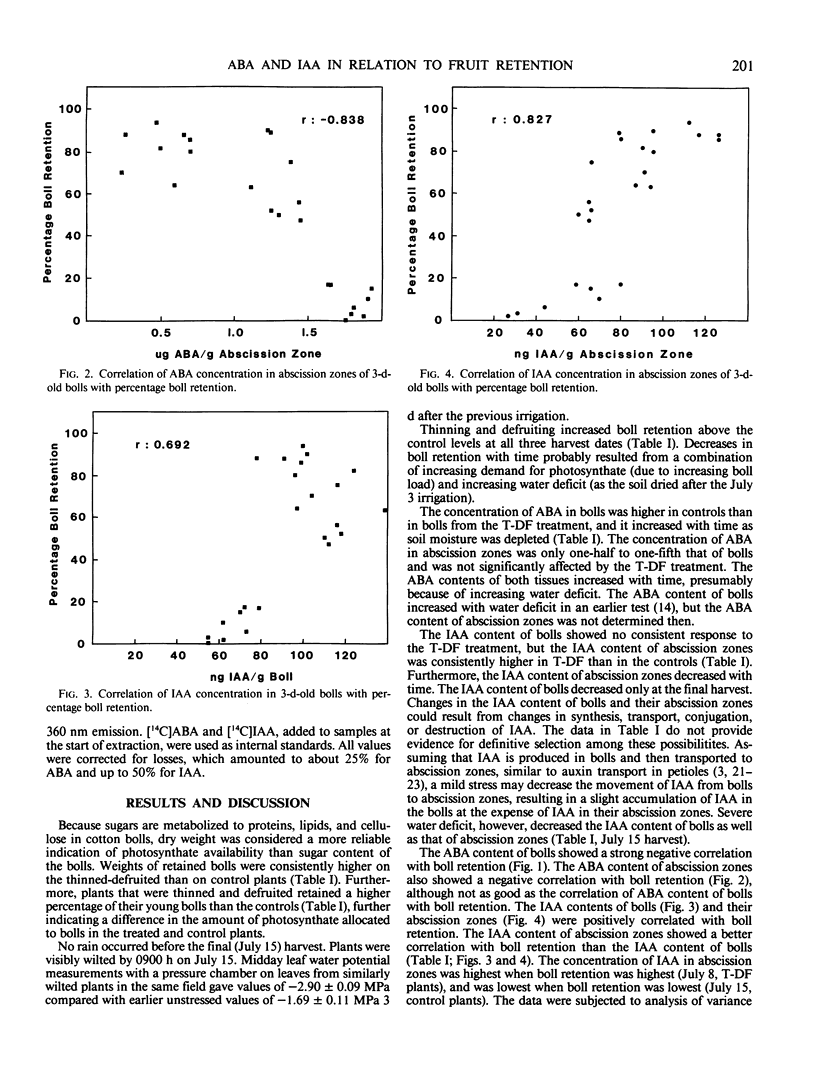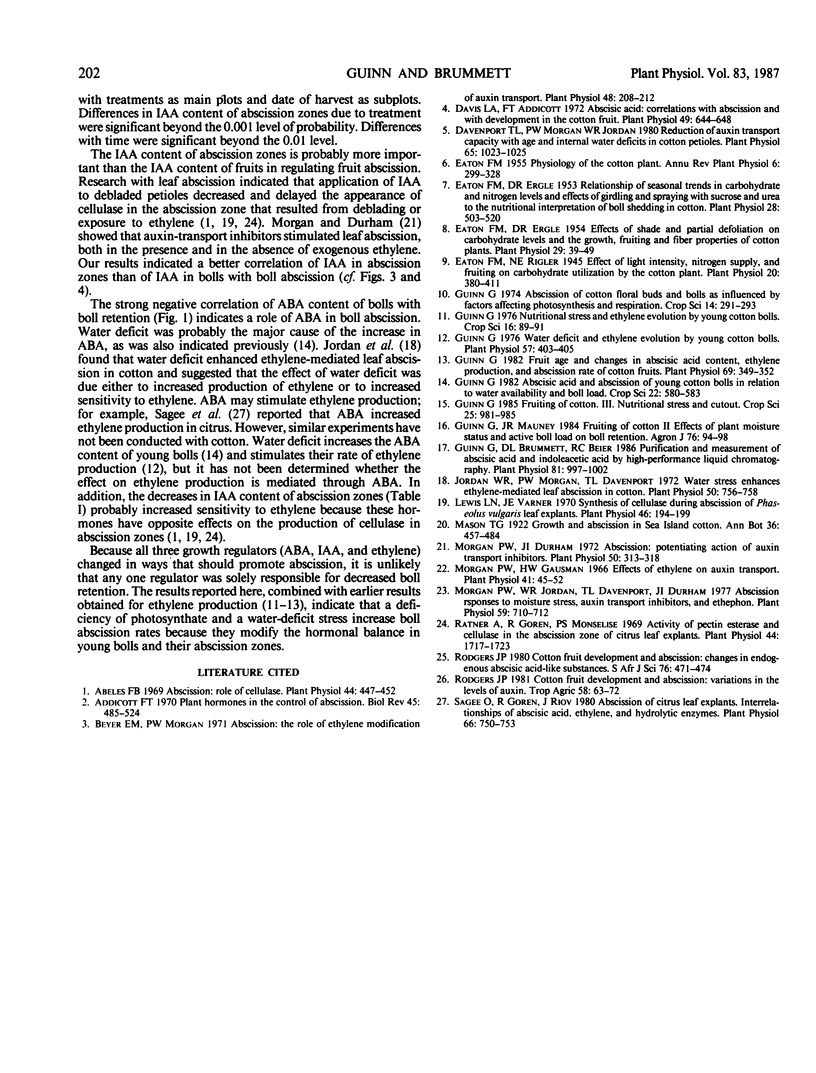Abstract
An experiment was conducted with field-grown cotton (Gossypium hirsutum L.) to determine the effects of drought and an increase in available photosynthate on the abscisic acid (ABA) and indoleacetic acid (IAA) contents of 3-day-old bolls and their abscission zones. Photosynthate availability was manipulated by removing about two-thirds of the plants to permit increased irradiance, and thus photosynthesis, in the plant canopy. The demand for photosynthate was decreased by removing all bolls from the remaining plants. The thinning and defruiting operations were performed about 3 weeks after first flower. Control plants were neither thinned nor defruited. Effects of water deficit were observed by making three harvests at different times during a 2-week irrigation cycle. Increasing the availability of photosynthate increased boll retention, but had relatively little effect on the concentrations of ABA and IAA in bolls. However, it did increase the concentration of IAA in abscission zones. Water deficit increased the ABA content of bolls and abscission zones and decreased the IAA content of bolls and abscission zones. Across all treatments, the IAA content of abscission zones was positively correlated, and the ABA content of bolls was negatively correlated, with boll retention. The results indicate that stresses change the hormonal balance in ways that are consistent with observed increases in fruit abscission.
Full text
PDF



Selected References
These references are in PubMed. This may not be the complete list of references from this article.
- Abeles F. B. Abscission: role of cellulase. Plant Physiol. 1969 Mar;44(3):447–452. doi: 10.1104/pp.44.3.447. [DOI] [PMC free article] [PubMed] [Google Scholar]
- Beyer E. M., Morgan P. W. Abscission: the role of ethylene modification of auxin transport. Plant Physiol. 1971 Aug;48(2):208–212. doi: 10.1104/pp.48.2.208. [DOI] [PMC free article] [PubMed] [Google Scholar]
- Davenport T. L., Morgan P. W., Jordan W. R. Reduction of auxin transport capacity with age and internal water deficits in cotton petioles. Plant Physiol. 1980 May;65(5):1023–1025. doi: 10.1104/pp.65.5.1023. [DOI] [PMC free article] [PubMed] [Google Scholar]
- Davis L. A., Addicott F. T. Abscisic Acid: correlations with abscission and with development in the cotton fruit. Plant Physiol. 1972 Apr;49(4):644–648. doi: 10.1104/pp.49.4.644. [DOI] [PMC free article] [PubMed] [Google Scholar]
- Eaton F. M., Ergle D. R. Effects of Shade and Partial Defoliation on Carbohydrate Levels and the Growth, Fruiting and Fiber Properties of Cotton Plants. Plant Physiol. 1954 Jan;29(1):39–49. doi: 10.1104/pp.29.1.39. [DOI] [PMC free article] [PubMed] [Google Scholar]
- Eaton F. M., Ergle D. R. Relationship of Seasonal Trends in Carbohydrate and Nitrogen Levels and Effects of Girdling and Spraying with Sucrose and Urea to the Nutritional Interpretation of Boll Shedding in Cotton. Plant Physiol. 1953 Jul;28(3):503–520. doi: 10.1104/pp.28.3.503. [DOI] [PMC free article] [PubMed] [Google Scholar]
- Eaton F. M., Rigler N. E. EFFECT OF LIGHT INTENSITY, NITROGEN SUPPLY, AND FRUITING ON CARBOHYDRATE UTILIZATION BY THE COTTON PLANT. Plant Physiol. 1945 Jul;20(3):380–411. doi: 10.1104/pp.20.3.380. [DOI] [PMC free article] [PubMed] [Google Scholar]
- Guinn G., Brummett D. L., Beier R. C. Purification and measurement of abscisic Acid and indoleacetic Acid by high performance liquid chromatography. Plant Physiol. 1986 Aug;81(4):997–1002. doi: 10.1104/pp.81.4.997. [DOI] [PMC free article] [PubMed] [Google Scholar]
- Guinn G. Fruit age and changes in abscisic Acid content, ethylene production, and abscission rate of cotton fruits. Plant Physiol. 1982 Feb;69(2):349–352. doi: 10.1104/pp.69.2.349. [DOI] [PMC free article] [PubMed] [Google Scholar]
- Guinn G. Water deficit and ethylene evolution by young cotton bolls. Plant Physiol. 1976 Mar;57(3):403–405. doi: 10.1104/pp.57.3.403. [DOI] [PMC free article] [PubMed] [Google Scholar]
- Jordan W. R., Morgan P. W., Davenport T. L. Water Stress Enhances Ethylene-mediated Leaf Abscission in Cotton. Plant Physiol. 1972 Dec;50(6):756–758. doi: 10.1104/pp.50.6.756. [DOI] [PMC free article] [PubMed] [Google Scholar]
- Lewis L. N., Varner J. E. Synthesis of Cellulase during Abscission of Phaseolus vulgaris Leaf Explants. Plant Physiol. 1970 Aug;46(2):194–199. doi: 10.1104/pp.46.2.194. [DOI] [PMC free article] [PubMed] [Google Scholar]
- Morgan P. W., Durham J. I. Abscission: potentiating action of auxin transport inhibitors. Plant Physiol. 1972 Sep;50(3):313–318. doi: 10.1104/pp.50.3.313. [DOI] [PMC free article] [PubMed] [Google Scholar]
- Morgan P. W., Gausman H. W. Effects of ethylene on auxin transport. Plant Physiol. 1966 Jan;41(1):45–52. doi: 10.1104/pp.41.1.45. [DOI] [PMC free article] [PubMed] [Google Scholar]
- Morgan P. W., Jordan W. R., Davenport T. L., Durham J. I. Abscission responses to moisture stress, auxin transport inhibitors, and ethephon. Plant Physiol. 1977 Apr;59(4):710–712. doi: 10.1104/pp.59.4.710. [DOI] [PMC free article] [PubMed] [Google Scholar]
- Ratner A., Goren R., Monselise S. P. Activity of pectin esterase and cellulase in the abscission zone of citrus leaf explants. Plant Physiol. 1969 Dec;44(12):1717–1723. doi: 10.1104/pp.44.12.1717. [DOI] [PMC free article] [PubMed] [Google Scholar]
- Sagee O., Goren R., Riov J. Abscission of Citrus Leaf Explants: INTERRELATIONSHIPS OF ABSCISIC ACID, ETHYLENE, AND HYDROLYTIC ENZYMES. Plant Physiol. 1980 Oct;66(4):750–753. doi: 10.1104/pp.66.4.750. [DOI] [PMC free article] [PubMed] [Google Scholar]


